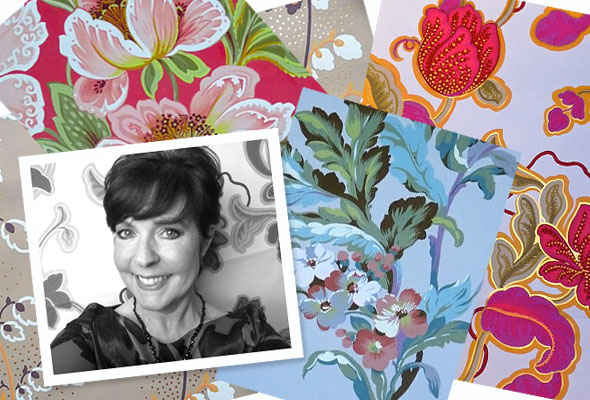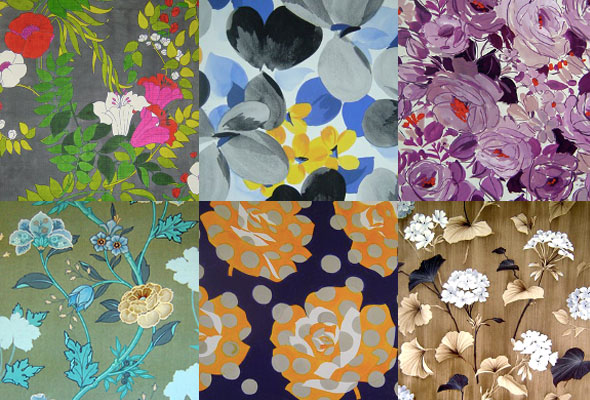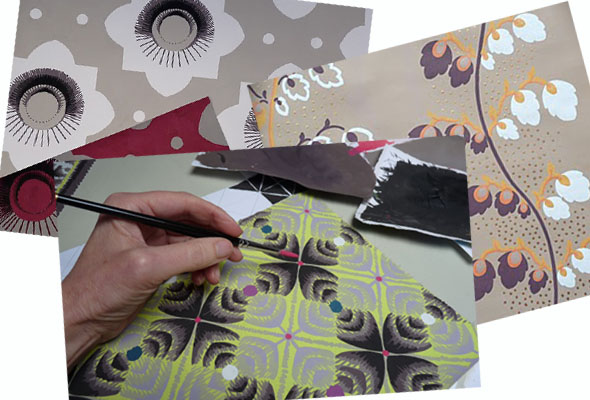Profile | Diane Marsland
InspirationA few months ago we posted about the recent discovery of work by former Parisian print studio, Lizzie Derriey. With Liberty’s support, the found prints were exhibited and available for sale at the store’s London location. One of our readers, Diane Marsland, commented on the post and revealed that she had designed for the studio back in the 80s. Intrigued, we decided to interview her about this creative heyday and find out how surface design has evolved since.
1. Tell us a little about yourself. How did you get started and what made you want to become a surface designer?
After leaving school quite young before my 16th birthday, I started a fashion design foundation course in the local polytechnic (college). I had every intention of becoming a fashion designer with a special interest in Costume and Theatre. However an opportunity came along and I was offered a job at a small independent textile design studio in Manchester. I experienced an apprenticeship style training and understudied with some amazing artists. Because of the accounts and consultancies we had, I was also able to work at the textile mills that were producing some of the designs we were creating. In the early days this included Dorma bed linen who had there own printing facility at the time and several other UK based mills. Later we worked at mills in Southern Africa. During this time our studio designed for most UK retailers (M&S, BHS, House of Fraser, Debenhams) and suppliers for bedlinen and soft furnishings. We also sold designs to USA, Canada, Australia, and South Africa.
2. We understand you received your training in Paris in the 1980s. Can you tell us about the design process? Were there any particular techniques practiced that you still use today? Where did your inspiration come from?
The connection to the Parisian Ateliers arose because of a lovely elderly gentleman called Rene Dorenlot who we used to call the Maurice Chevalier of the design world. He knew everyone who was important at the time and he made all the introductions and therefore gave us young designers the opportunity of working at the studios which not only included Lizzie Derriey but Studio Kitler, and several others in Paris. We also worked with Studio Wagner in Krefeld, Germany and a few studios in Como, Italy. Foreign designers would come over to Manchester and work with us also. These were wonderful days, active, varied and fun…I have many stories about this time which would fill a book…too many to mention in this short interview.
The creation of the design was all done by hand using basic materials – paper, gouache, sable brushes. The European studios, especially the Italians, were a bit more experimental using other mediums, lots of gloss, acetate, and collage. However, some of the colour separation artists and printers were not happy about this because the designs would have to be re-drawn and translated in order to be produced. This sometimes resulted in a totally different look to the idea which was originally purchased. Our studio prided itself in being able to design within the technical restrictions. We were also able to interpret the flamboyant European style and keep the look. We had a colour separation department so all of us understood the process, not to forget our ongoing involvement with the printing and production in the mills, which gave our designers a unique insight into the technicalities and how the end product would finally look.
All the techniques that I was taught and used in the past I still use today. The studio catered for so many markets that we had to cover most of the styles and techniques anyway. Great groundwork for whatever trends and styles are required in the future.
I love this question “Where did your inspiration come from?” Inspiration can come from many areas but it is definitely not “Divine Intervention.” I do not believe that an idea comes in a flash even though I can wake up in the morning with a thought or answer to a creative problem I have been trying to solve.
Inspiration in the past came from the same places that it comes from today. The market place, the economy, constantly looking at everything around you, putting all this information together and then hopefully interpreting it and creating an image that fits the purpose that it is intended for. It is great when a designer is working on speculative work for a collection to show at an exhibition because they can release all their ideas. It is a little more restrictive when working to an exact brief but may show how inspired a designer can be within the parameters.
3. You worked for a few studios in Paris including Lizzie Derriey Studio. What types of prints did you create during this time and who were your clients?
Even though I was trained to cover most styles and techniques my specialities had always been decorative and classic florals. When I went to the European studios I understudied the floral artists which had a looser, more impressionistic and flamboyant style than mine. This encouraged me to free up my technique. In the early 80s there was a fashion for impressionistic and washy florals as well as the broad brushwork abstracts. The Abstract were intended for fashion prints but they were also adapted for various bedlinen companies as well.
Before designers began exhibiting at large design fairs like Indigo and Surtex, and the designer halls at Heimtex, most designs were sold from the showrooms of the design studios. Therefore the buyers and clients would generally visit all these studios by appointment. They would have special design buying trips planned in their schedule at various times of the year, pounding the streets of Paris, Como, etc. Studios would also send out their Sales people to also pound the streets with their weighty portfolios and sometimes hope to sell a design or collection. It is perhaps a little less stressful now as everyone is under one roof.
In the old days the studio had very strict rules regarding the exposure of designers to clients. Our UK studio was less strict and we got to see most of the clients. However, the European studios, especially the French ones, were quite obsessed about this. If they had a good designer who’s designs were selling well, they did everything in their power to keep them under wraps. Most larger and successful studios would employ sales people that were not designers and this would limit the exposure and therefore poaching of designers. Obviously we got to hear when a representative from a large fashion house or buyer from a retail group was in town and “doing the rounds” and we would try and “hover” around the showroom or help with the refreshments. I met a few famous people in the past but my favourite was the UK Fashion designer, Zandra Rhodes, who was lovely.
4. How has surface design changed since you started you career?
I think that it is less about how surface design has changed over the years but more about how the industry and the people in the industry have changed which in lots of ways is almost unrecognizable to when I first started out.
Patterns and designs are always evolving and trends are forever doing “full circle” and coming back. New technology is allowing more people to create but overall design has not changed that much. Ironically design for Homewares is more simple, especially in format. The technical possibilities do not seem to have been fully exploited yet as the market does not seem to require complicated layouts, lots of print options or very detailed artwork.
The Designer/Maker is on the increase with cottage industries thriving with the love for individual and handmade. I have recently thought that this reminds me of the William Morris Arts and Crafts movement in the late 19th century…a fear of the machine replacing the craftsman. Obviously I can only give you my opinions and views as to what I see the changes are – all based on my experiences. I would be interested to know of other designers out there and what they think about this subject.
5. Do you have any tips or advice for designers just starting out in the industry?
It’s the “Gold Rush” at the moment in the surface pattern world. The market’s thirst for pattern at the moment is everywhere. When I came back from Pakistan in 2003 (where I had been working for a mill) I had built up a collection of designs to sell as a freelance designer. But, the UK market in Interiors was saturated with Minimalism, weaves, textures and lots of beige. I had to rethink everything and that is when I decided to go into interior design. I only returned to surface design last year when the “Gold Rush” had established itself again.
My advice to young designers would be to acquire as many skills as possible and when the Beige world rears its ugly head again you will have a better opportunity to survive the situation.
To view further samples and to learn more about Diane’s process, visit her site here.
– Jessie Whipple Vickery





Thanks Jessie for publishing this ……..I hope that everyone enjoys reading it.
Very insightful. I hope the era of minimalism and beige never returns.
Great interview, Jessie and Diana. Loved hearing about Diana’s studio experiences in the 80s.
Wow, this is a fantastic interview! As a surface designer (American but living/working in Europe for the past 4 years) – it is nice to read about the experiences of an extablished artist within the same field. Thank you for sharing Jessie (and beautiful work, Ms. Marsland!).
Comments are closed.